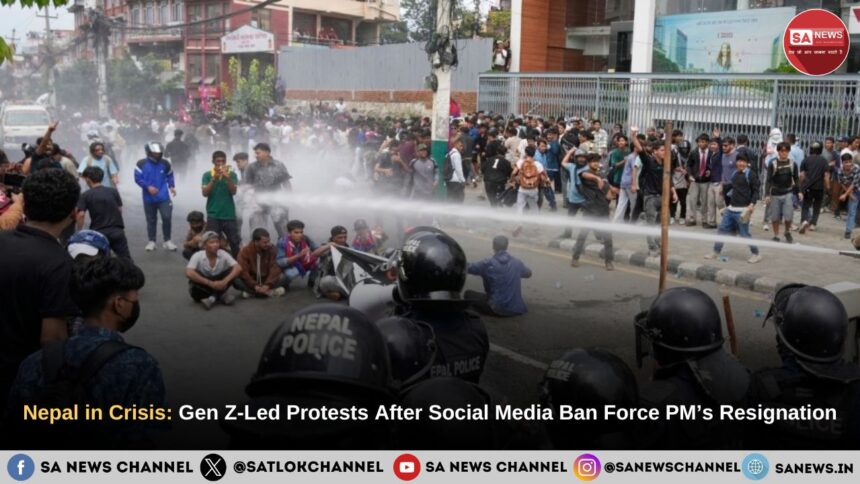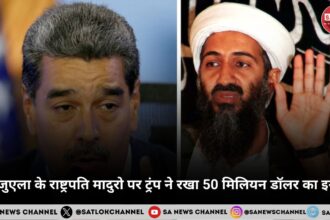Nepal has plunged into its worst political crisis in decades as Generation Z-led protests against corruption and government censorship have claimed at least 22 lives and forced Prime Minister KP Sharma Oli to resign. What began as opposition to a social media ban has escalated into a nationwide revolt against systemic corruption, nepotism, and decades of political mismanagement.
The streets of Kathmandu and other major cities have transformed into battlegrounds, with protestors clashing with security forces, and government buildings, including the Parliament, set ablaze. The turmoil has forced the closure of Tribhuvan International Airport and led to the deployment of the Nepali Army to secure key infrastructure.
- Nepal’s Prime Minister KP Sharma Oil Resigns
- What we know: The Catalyst for Nationwide Unrest
- The “Nepo Kids” Campaign Fuels Anger
- Nepal’s Struggle Against Corruption and Governance Failures
- Political Instability and Failed Governance
- Economic Crisis and Youth Unemployment
- Tragic Escalation and Human Cost
- Attacks on Political Leaders and Their Families
- Breakdown of Law and Order
- The Innocent Victims and Broader Implications
- Regional and International Concerns
- The Path Forward: Uncertain Prospects
- Structural Challenges Ahead
- Spiritual Perspective: Violence never brings Prosperity
Nepal’s Prime Minister KP Sharma Oil Resigns

Nepal’s Prime Minister KP Sharma Oil was forced to resign and has fled to Dubai after facing huge backlash from the public outrages due to the ban of social media apps and the underlying roots of corruption.
As per the reports, 22 people were killed while many injured while clashing with the police. Apart from this, the protestors also burnt the parliament house of Nepal while attacking and burning down the houses of several ministers.
What we know: The Catalyst for Nationwide Unrest
On September 4, 2025, Nepal’s government implemented a sweeping ban on 26 major social media platforms, including Facebook, Instagram, WhatsApp, YouTube, and X (formerly Twitter). The government cited concerns about fake accounts, hate speech, misinformation, and cybercrime, requiring platforms to register with the Ministry of Communications and Information Technology within seven days.
For a generation that lives, communicates, and works online, the blackout was seen as a direct assault on freedom of expression and a blatant attempt to silence dissent. This move proved to be the “straw that broke the camel’s back,” igniting simmering public anger and driving thousands into the streets. While the government has since lifted the ban in a desperate attempt to quell the unrest, the protests have only intensified, shifting their focus to the root causes of national frustration.
However, the ban was widely perceived as an attempt to silence growing anti-corruption movements that had gained traction on social media platforms. Critics viewed it as governmental overreach aimed at suppressing digital freedoms and curtailing the youth’s primary means of communication and activism.
The timing proved particularly damaging, as Nepal’s economy heavily relies on remittances from approximately 2 million workers abroad, many of whom depend on these platforms to communicate with families. With remittances accounting for 33.1% of Nepal’s GDP which is one of the highest rates globally and this ban effectively severed crucial economic and social connections.
The “Nepo Kids” Campaign Fuels Anger
Prior to the ban, a viral social media campaign targeting the lavish lifestyles of politicians’ children had been gaining momentum across platforms like TikTok and Reddit. The #NepoKids and #NepoBaby trends exposed how children of political elites flaunted luxury cars, foreign education, designer clothing, and expensive vacations while ordinary Nepalis struggled with poverty and unemployment.
Videos and images allegedly showed politicians’ children displaying Louis Vuitton items, dining at upscale restaurants, and posing with luxury Mercedes vehicles. These posts created stark contrasts with the daily hardships faced by average Nepalis, where 25% of the population lives below the poverty line. One widely shared Reddit post stated: “Children of elite politicians know exactly where their parents’ money and luxury come from taxpayers like you and me. While we struggle, they live in utter privilege”.
Nepal’s Struggle Against Corruption and Governance Failures
Nepal has long been plagued by pervasive corruption and governmental mismanagement. Transparency International ranks Nepal among the most corrupt countries in Asia, with 84% of the population believing corruption is a major problem. The protests reflect deep-seated frustrations with politicians who entered politics as humble party workers but now display extravagant lifestyles despite modest official salaries.
The corruption extends beyond individual enrichment to systematic “elite capture” of national resources. Government officials have been accused of misusing public funds to support lavish lifestyles, with their children receiving privileged access to foreign education and business opportunities. This has created a stark divide in a nation with a per capita annual income of approximately $1,400.
Political Instability and Failed Governance
Nepal’s current crisis is rooted in decades of chronic political instability. Since transitioning to a republic in 2008, the country has cycled through 14 different governments, with none completing a full five-year term. This pattern of instability has prevented consistent policy implementation and sustainable development.
The proportional representation system, while inclusive, has led to fragmented parliaments where no single party can govern alone, resulting in frequent coalition collapses and policy discontinuity. The constant political upheaval has stalled economic growth and reform initiatives, exacerbating the conditions that fuel public discontent.
Economic Crisis and Youth Unemployment
The protests have been driven by severe economic hardships, particularly affecting young people. Youth unemployment stands at approximately 20%, with many observers noting that 32.6% of unemployed Nepali youth are not pursuing education, compared to 23.5% in neighboring India. This economic desperation has forced massive emigration, with over 741,000 Nepalese leaving for foreign employment in the past year alone.
Also Read: The Future of Work in the Age of AI: Risks, Opportunities, and Survival Skills
The economic crisis is compounded by Nepal’s heavy dependence on remittances from overseas workers, making the social media ban particularly damaging as it disrupted communication channels essential for maintaining these economic lifelines.
Tragic Escalation and Human Cost
The protests turned deadly on Monday, September 8, when security forces opened fire on demonstrators attempting to breach Parliament and other government facilities. Police used live ammunition, rubber bullets, tear gas, and water cannons against largely unarmed protesters, resulting in 19 fatalities on the first day alone. The violence continued into Tuesday, with the death toll rising to at least 22 people and over 300 injured.
Medical professionals treating the wounded reported gunshot wounds and injuries from rubber bullets, highlighting the disproportionate use of force against young demonstrators. The heavy-handed response only intensified public anger and expanded the scope of protests beyond the original social media ban.
Attacks on Political Leaders and Their Families
As protests escalated on Tuesday, demonstrators targeted government buildings and the residences of political figures across the nation. The violence reached its most tragic point when Rajyalaxmi Chitrakar, wife of former Prime Minister Jhalanath Khanal, died after being trapped in her burning home. According to family sources, protesters surrounded the house in Kathmandu’s Dallu area and set it ablaze while she was inside, leading to severe burns that proved fatal despite emergency medical treatment.
The attacks extended to other senior politicians, including former Prime Minister Sher Bahadur Deuba and his wife, Foreign Minister Arzu Rana Deuba, who were physically assaulted by mobs. Disturbing videos showed Finance Minister Bishnu Prasad Paudel being chased through Kathmandu streets and brutally beaten by protesters. Government properties, including the Parliament building, President’s residence, and party headquarters, were set on fire.
Breakdown of Law and Order
The crisis has led to a complete breakdown of governmental authority, with the Nepal Army assuming control of security operations from 10 PM on Tuesday. Army Chief Ashok Raj Sigdel issued warnings against continued vandalism while calling for dialogue, but the military’s authority to use force remains unclear.
The chaos has resulted in 900 inmates escaping from two correctional facilities in western Nepal, airports being closed due to security concerns, and multiple countries issuing travel advisories. India’s border with Nepal has been placed on high alert to prevent spillover violence.
The Innocent Victims and Broader Implications
The violent escalation has tragically claimed numerous innocent lives, with most casualties being young protesters seeking systemic change. The death of Rajyalaxmi Chitrakar, who had no direct involvement in politics, represents the most devastating example of how violence has targeted innocent family members. Her death has been condemned as a “barbaric act” that reflects the dangerous turn of the movement.
The protests have also displaced families and disrupted daily life across Nepal, with curfews imposed in major cities and essential services affected. The closure of Tribhuvan International Airport and suspension of international flights have isolated Nepal from the outside world during the crisis.
Regional and International Concerns
The crisis has attracted international attention and concern, with neighboring India’s Prime Minister Narendra Modi calling the violence “heart-wrenching” and emphasizing Nepal’s importance for regional stability. Russia has expressed concern and advised its citizens against traveling to Nepal, while Israel has issued similar advisories.
The breakdown of democratic institutions in Nepal poses broader implications for regional stability, given the country’s strategic location between China and India. The crisis has highlighted the fragility of South Asian democracies and the challenges of managing youth-driven political movements in the digital age.
The Path Forward: Uncertain Prospects
Despite the army’s call for dialogue and the resignation of key political figures, the fundamental grievances driving the protests remain unaddressed. Protesters continue to demand establishment of an independent anti-corruption watchdog, accountability for decades of misgovernance, and genuine opportunities for economic advancement.
The absence of clear protest leadership complicates potential negotiations, as the movement emerged organically through social media coordination rather than traditional political organization. This grassroots nature, while demonstrating authentic public sentiment, makes it difficult to identify representatives for formal dialogue.
Structural Challenges Ahead
Nepal faces the enormous challenge of rebuilding trust between citizens and political institutions while addressing the underlying economic and governance failures that sparked the crisis. The country’s history of political instability suggests that cosmetic changes may not be sufficient to address the deep-seated issues driving public discontent.
The economic crisis, youth unemployment, and corruption that fueled these protests require comprehensive structural reforms that previous governments have failed to implement. Without addressing these fundamental challenges, Nepal risks continued cycles of instability and violence that could claim more innocent lives and further undermine democratic governance.
The current crisis represents a generational inflection point for Nepal, where the digital-native youth have demonstrated their power to challenge entrenched political systems. However, the tragic cost in human lives and the breakdown of institutional order highlight the urgent need for peaceful, democratic solutions to address the legitimate grievances of Nepal’s people.
Spiritual Perspective: Violence never brings Prosperity
Sant Rampal Ji elaborates how violence never brings prosperity rather makes things worse. He explains how precious and pious this human life is and how we should live with peace and harmony discouraging the negatives of society. We are supposed to utilize this life into spiritual revelations and follow the right way of devotion as prescribed in our holy scriptures.
मनुष्य जीवन का कार्य क्या है? | Sant Rampal Ji Satsang | SATLOK ASHRAM
Sant Rampal Ji Maharaj, through scriptural evidence, explains that in this Kaliyuga, the only path to peace and security is true devotion, which can only be imparted by a complete saint. He emphasizes that real safety lies not in bunkers or weapons but in seeking refuge in the Supreme Being who can protect us from all kinds of disasters and crises.
FAQs
1. Why did the protests in Nepal start?
The protests began after the government banned 26 major social media platforms, including Facebook, Instagram, WhatsApp, YouTube, and X. For Gen Z, this was seen as a direct attack on freedom of expression, sparking outrage that quickly grew into a nationwide movement.
2. Why is Gen Z leading the protests?
Gen Z in Nepal has grown up online and relies heavily on social media for communication, work, and activism. They’ve also been hit hardest by unemployment and corruption, making them the driving force behind the revolt.









